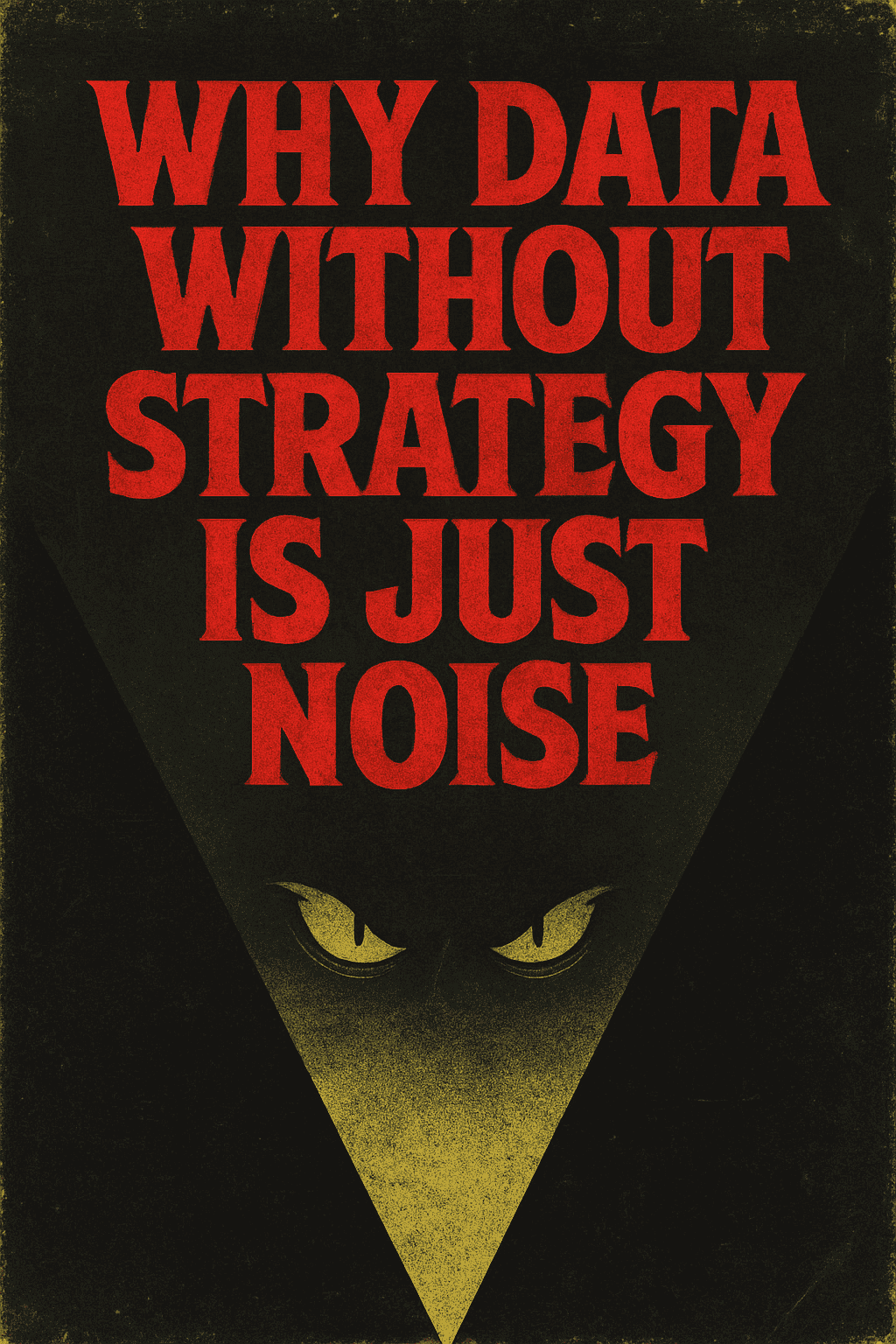
The Numbers Are Lying to You
You check your analytics dashboard, and the graphs look good—visits are up, time on site is up, and your bounce rate is down. But your phone isn’t ringing any more than last month. No new leads, no new sales, no measurable growth.
Welcome to the modern marketer’s paradox: we’re surrounded by more data than ever, yet most of it tells us nothing useful.
It’s like listening to a hundred radios at once—everything is playing, but you can’t make out the tune.
Data without strategy is just noise. It distracts you with movement but hides the lack of direction.
The Illusion of Insight
We live in an age of dashboards, metrics, and beautifully color-coded charts. It’s never been easier to track what’s happening, but that doesn’t mean we know why it’s happening.
Businesses obsess over impressions, clicks, and followers—numbers that look impressive in a report but don’t necessarily translate into profit.
It’s the same as counting how many people walked past your storefront instead of how many came in and bought something.
When data becomes a scoreboard instead of a guide, strategy disappears.
The Comfort of Measurement
Numbers feel safe.
They give us something solid to hold onto when the market shifts or when a campaign feels uncertain.
But comfort isn’t clarity.
You can measure every click, every page view, and every scroll depth, but if you don’t know what you’re measuring for, you’re wasting time and attention.
In many companies, data replaces critical thinking. The conversation shifts from “What’s working?” to “What can we track?”
A successful business doesn’t need more metrics—it needs better questions.
When Data Becomes Distraction
Imagine a ship’s captain staring at dozens of blinking gauges, each showing something different—wind direction, humidity, wave height, engine pressure. All accurate, none useful unless he knows where he’s going.
That’s what happens when teams chase metrics without a clear destination.
Marketing teams proudly report that traffic increased by 30%, but can’t connect it to revenue. Sales teams collect endless customer data but never use it to refine messaging. Leaders demand dashboards instead of direction.
The noise gets louder, and decisions get slower.
The Real Cost of Data Without Strategy
Data without strategy doesn’t just waste time—it actively hurts growth.
Here’s how:
- It fragments your focus. You start optimizing for random numbers instead of meaningful goals.
- It misleads your team. People chase vanity metrics instead of impact. Everyone feels busy, but progress stalls.
- It builds false confidence. Success on paper masks weakness in practice. The numbers look fine right up until sales crash.
- It dilutes your message. When you try to please every metric, your marketing loses focus and your story gets lost.
- It blinds you to context. You start trusting charts more than customers. The data may be correct, but it’s disconnected from reality.
The cost isn’t just financial—it’s cultural. Teams lose curiosity and start treating analytics as gospel.
Why Strategy Must Come First
Strategy gives meaning to data.
Without it, analytics are like puzzle pieces with no picture on the box. You can collect them all, but you’ll never see what you’re building.
A strong marketing strategy defines:
- The goal (What are we trying to achieve?)
- The audience (Who do we need to reach?)
- The message (What do they need to hear?)
- The metric (How will we know it’s working?)
Once those are in place, data becomes a powerful ally. It stops being random noise and starts serving a purpose.
When you know why you’re measuring something, every number tells a story.
The Myth of “More Data, Better Decisions”
We’ve been sold a dangerous idea: that the more data you collect, the smarter your business becomes.
In reality, the opposite is often true.
Too much data overwhelms decision-making. It creates analysis paralysis—where teams spend weeks arguing over numbers instead of acting.
True intelligence comes from focus, not volume.
It’s better to track three meaningful metrics that align with your goals than fifty that don’t.
Think of it like trying to tune an instrument—you don’t need to hear every note in the orchestra to know when your guitar is off-key. You just need the right pitch.
The Vanity Metrics Trap
Every business falls into this trap at some point. You start celebrating the easy numbers: likes, views, followers, clicks.
They’re seductive because they move fast. They rise and fall daily, giving you a dopamine hit that feels like success.
But vanity metrics rarely correlate with business results.
You can have ten thousand followers and still not sell a single product. You can double your website traffic and not gain one new client.
Real success comes from behavioral metrics—actions that indicate trust and intent:
- Form submissions
- Calls or appointments booked
- Repeat visitors
- Email engagement
- Average order value
- Referral traffic from satisfied clients
Those are the numbers that matter because they reflect real human connection.
The Human Side of Data
Behind every data point is a person.
That sounds obvious, but it’s easy to forget when you’re staring at spreadsheets.
Each “session” in Google Analytics represents a human being who made a decision—to click, to leave, to read, to trust.
When you remember that, data stops feeling sterile. It becomes emotional again.
You start asking questions like:
- Why did they click that?
- What were they hoping to find?
- Where did they lose interest?
- What made them hesitate?
Those questions lead to empathy—and empathy is what drives good strategy.
Marketing isn’t about manipulating data; it’s about understanding people.
Turning Chaos Into Clarity
So how do you turn your mountain of metrics into something meaningful?
It starts with simplification.
1) Define one clear outcome.
Do you want more leads, more qualified calls, higher conversions, or stronger brand awareness? Pick one priority. Everything else is secondary.
2) Identify the leading indicators.
What early signs tell you that you’re moving toward your goal? For example: if your goal is leads, your indicators might be time on key pages or form completions.
3) Remove what doesn’t matter.
Delete or hide metrics that don’t connect directly to your strategy. This declutters your dashboard and your mind.
4) Establish context.
Compare data over consistent time periods. Look for trends, not isolated spikes.
5) Act on insights, not observations.
A drop in traffic is just an observation. Knowing why it dropped and what to do next—that’s insight.
Strategy is the lens that turns random data into actionable direction.
When Gut Instinct Meets Data
A good strategist doesn’t choose between instinct and data—they blend them.
Gut instinct gives you the hypothesis; data tests it.
If you rely only on intuition, you risk bias. If you rely only on data, you lose vision.
The sweet spot lies in between.
The best marketing decisions often begin with a hunch: “I think our audience prefers seeing our team rather than stock photos.” Then data proves (or disproves) that intuition through testing.
Data validates your instincts. Strategy gives them purpose.
The Danger of Automation Without Understanding
Automation tools promise to make data management effortless. You connect your analytics, CRM, and ad platforms, and suddenly your reports build themselves.
Convenient, yes—but dangerous if you’re not interpreting them correctly.
Automation magnifies both clarity and confusion. If your data is poorly structured, automation will amplify the chaos.
Tools can collect and visualize information, but they can’t think for you.
You still need human strategy to decide:
- What questions matter
- Which patterns deserve attention
- When to ignore outliers
- How to turn insight into action
Technology helps us see faster, but strategy helps us see right.
The False Comfort of Big Numbers
We’re drawn to large numbers. They make us feel like something’s happening.
But big doesn’t always mean good.
A spike in traffic might be the result of bots, irrelevant audiences, or one viral post that never converts. A drop might mean your targeting improved and you’re now attracting the right people.
Context determines meaning.
When you chase numbers without context, you make decisions that look good in reports but hurt in real life.
The Power of Strategic Measurement
Imagine two companies with identical analytics data:
- 10,000 monthly visitors
- 4% conversion rate
- 15% returning users
Company A celebrates. Company B investigates.
Company B asks: Which pages are converting? Which audience segments are driving that 4%? What content brings them back?
They focus their efforts on what matters and double their conversion rate in three months.
That’s the power of strategy. The numbers didn’t change—just the understanding of them.
The Importance of a Feedback Loop
Data without a feedback loop becomes static.
You must connect insights to action and action back to insight.
For example:
- You notice visitors drop off after reading your service page.
- You revise the copy for clarity and add a call to action.
- You measure engagement again.
If engagement rises, you’ve learned something valuable. If it drops, you’ve learned something even more valuable.
Strategy turns data into an ongoing conversation rather than a one-time report.
How Strategy Shapes Better Questions
The right strategy doesn’t just answer questions—it changes which questions you ask.
Without strategy, you ask:
- “How many people visited our site?”
- “What’s our click-through rate?”
- “How many impressions did this ad get?”
With strategy, you ask:
- “Did the right people visit our site?”
- “What message convinced them to click?”
- “Which part of the ad led to conversions?”
The first set of questions measures activity. The second set measures impact.
Strategy reframes curiosity around purpose.
The Evolution of Data in 2026
The next few years will only amplify this divide between noise and strategy.
AI is generating more content, automating reports, and predicting outcomes faster than humans can read them. But if everyone has the same access to data, the advantage no longer comes from having it—it comes from interpreting it better.
In 2026, the businesses that win will be those that:
- Understand their audience deeply
- Use data to validate strategy, not replace it
- Focus on clarity over complexity
- Maintain a human voice in automated systems
As automation and AI expand, your ability to create meaning from data will define your competitive edge.
The Two Campaigns
Let’s imagine two marketing campaigns.
Campaign A: The company tracks every available metric—impressions, reach, video views, dwell time, and scroll depth. Reports look impressive, but no one connects the dots to revenue.
Campaign B: The company defines a single goal—to increase qualified leads by 20%. They identify one core audience and track only three metrics: landing page visits, form submissions, and follow-up conversion.
After 60 days, Campaign A has pages of data but no clarity. Campaign B knows exactly what worked and why.
That’s the difference between information and intelligence.
The Strategic Data Hierarchy
To keep your analytics useful, build a simple hierarchy:
- Purpose – Why are we collecting this data?
- People – Who will use it and how?
- Process – How often will it be reviewed?
- Performance – What outcome will signal success?
Every metric should pass through those four filters before it earns a place on your dashboard.
If it doesn’t serve the purpose, it’s noise.
How to Build a Strategy-First Data Culture
Transforming how your team uses data doesn’t happen overnight. It requires cultural change.
Here’s how to start:
1) Teach interpretation, not collection.
Make sure your team understands what each metric means and how it supports the goal.
2) Reward clarity, not complexity.
A one-page report that drives action is worth more than a ten-page one no one reads.
3) Encourage questions.
A good strategist isn’t afraid to challenge data that doesn’t make sense.
4) Align teams around shared goals.
When marketing, sales, and leadership all track the same outcomes, data stops competing with itself.
5) Review and refine regularly.
Metrics evolve as your business does. Schedule consistent reviews to remove outdated measures.
Culture shifts when people see how data actually drives success—not just when they’re told it should.
The Simplicity Advantage
Complexity is seductive, but simplicity scales.
When your reporting is simple, your strategy stays sharp.
A cluttered dashboard is like a cluttered mind—it feels busy but produces confusion.
The best dashboards answer one question: Are we getting closer to our goal?
If they can’t answer that, they’re not dashboards—they’re decoration.
Why Clarity Beats Quantity
Clarity creates confidence.
When you and your team know exactly which metrics matter, you can move faster, communicate better, and adapt quickly.
Quantity creates hesitation.
When everyone’s chasing different numbers, no one knows which one defines success.
Clarity turns data into momentum.
The Emotional Side of Strategy
We often treat marketing data as cold and logical, but strategy is deeply emotional.
You’re not just reading numbers—you’re reading behavior, trust, and intent.
The best strategists feel the story behind the stats.
They see that a spike in returning users might mean people are finally connecting with your message. That a dip in form submissions might reflect confusion rather than disinterest.
Emotion turns observation into empathy, and empathy turns marketing into meaning.
The Long Game of Measurement
Short-term spikes are exciting, but sustainable growth comes from consistency.
When you focus on long-term trends rather than daily noise, you start seeing patterns that reveal how your brand actually behaves in the market.
It’s like watching the tide instead of chasing waves.
Every data point contributes to a bigger picture—but only if you stay long enough to see it form.
Strategy demands patience.
How to Filter Out the Noise
If you want your data to work harder for you, start with a few simple filters:
- Relevance Filter – Does this metric connect directly to our goal?
- Action Filter – Can we do something with this information?
- Time Filter – Is this a trend or just a temporary fluctuation?
- Impact Filter – Does this insight change how we operate?
If a metric fails any of those tests, it belongs in the background—not the boardroom.
The Role of Creativity in Data Strategy
Strategy doesn’t mean rigidity. It means discipline plus imagination.
Creativity turns insights into campaigns that connect emotionally.
When you understand your data deeply, you can design experiences that resonate:
- Adjust your messaging to match what people actually search for.
- Redesign pages that people abandon most often.
- Double down on the content that drives returning visitors.
Data gives you direction. Creativity gives you soul. Together, they create momentum.
The Future of Intelligent Marketing
As we move into 2026, we’ll see marketing split into two camps:
- The data-heavy but directionless. These teams will drown in dashboards, chasing metrics that change weekly.
- The strategy-focused and selective. These teams will collect less but act more, using insights to create lasting growth.
The future belongs to the second group.
Because the goal of data isn’t to measure everything—it’s to measure what matters.
Bringing It All Together
Let’s be honest—data isn’t going away. Nor should it.
But it’s time we stop worshipping it.
The value of data lies not in the numbers themselves but in the story they tell when guided by purpose.
When you have a clear strategy:
- Reports make sense.
- Teams align.
- Decisions move faster.
- Customers feel the difference.
Without strategy, even the best tools become noise. With it, even simple metrics become music.
The Quiet Power of Focus
When you focus your data on a single objective, everything gets quieter.
The noise fades.
You start to hear the rhythm of your business—the patterns that matter, the signals that guide, the feedback that fuels improvement.
That’s when data finally becomes what it was meant to be: a reflection of your strategy, not a replacement for it.
Stop Measuring Everything and Start Making Moves
The businesses that thrive in 2025 and 2026 won’t be the ones with the most data. They’ll be the ones who use data wisely—those who pair it with a clear purpose, a defined strategy, and the courage to ignore distractions.
Because at the end of the day, data doesn’t drive success. Decisions do.
And smart decisions come from strategy, not noise.
If your reports look impressive but your results feel flat, it’s time to connect your numbers to a real strategy.
At Graticle Design, we help businesses turn analytics into action. We look beyond dashboards to uncover what your audience truly responds to—and we design websites and campaigns that turn data into direction.
Let’s talk about how to quiet the noise and build a strategy that actually works.





